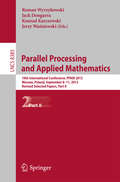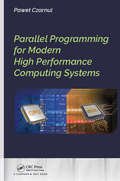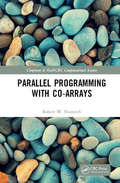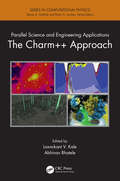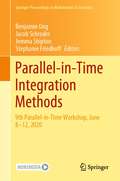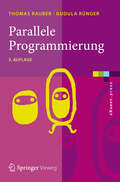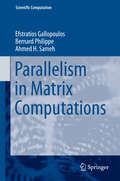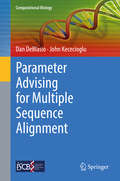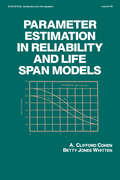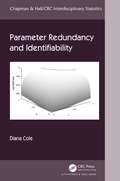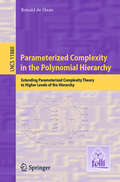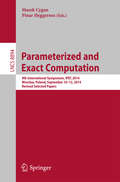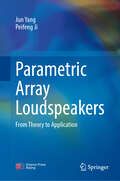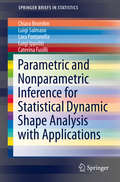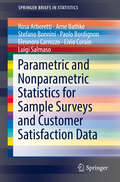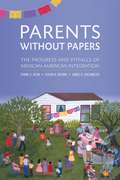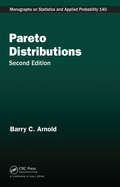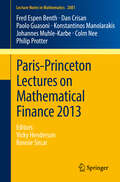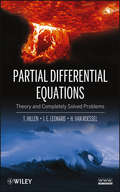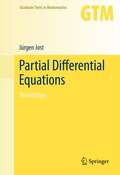- Table View
- List View
Parallel Processing and Applied Mathematics
by Jerzy Waśniewski Roman Wyrzykowski Jack Dongarra Konrad KarczewskiThis two-volume-set (LNCS 8384 and 8385) constitutes the refereed proceedings of the 10th International Conference of Parallel Processing and Applied Mathematics, PPAM 2013, held in Warsaw, Poland, in September 2013. The 143 revised full papers presented in both volumes were carefully reviewed and selected from numerous submissions. The papers cover important fields of parallel/distributed/cloud computing and applied mathematics, such as numerical algorithms and parallel scientific computing; parallel non-numerical algorithms; tools and environments for parallel/distributed/cloud computing; applications of parallel computing; applied mathematics, evolutionary computing and metaheuristics.
Parallel Processing and Applied Mathematics
by Jerzy Waśniewski Roman Wyrzykowski Jack Dongarra Konrad KarczewskiThis two-volume-set (LNCS 8384 and 8385) constitutes the refereed proceedings of the 10th International Conference of Parallel Processing and Applied Mathematics, PPAM 2013, held in Warsaw, Poland, in September 2013. The 143 revised full papers presented in both volumes were carefully reviewed and selected from numerous submissions. The papers cover important fields of parallel/distributed/cloud computing and applied mathematics, such as numerical algorithms and parallel scientific computing; parallel non-numerical algorithms; tools and environments for parallel/distributed/cloud computing; applications of parallel computing; applied mathematics, evolutionary computing and metaheuristics.
Parallel Processing and Applied Mathematics: 4th International Conference, Ppam 2001, Naleczow, Poland, September 9-12, 2001, Revised Papers (Lecture Notes in Computer Science #2328)
by Roman Wyrzykowski Ewa Deelman Jack Dongarra Konrad KarczewskiThe two-volume set LNCS 10777 and 10778 constitutes revised selected papers from the 12th International Conference on Parallel Processing and Applied Mathematics, PPAM 2017, held in Lublin, Poland, in September 2017.The 49 regular papers presented in this volume were selected from 98 submissions. For the workshops and special sessions, that were held as integral parts of the PPAM 2017 conference, a total of 51 papers was accepted from 75 submissions. The papers were organized in topical sections named as follows:Part I: numerical algorithms and parallel scientific computing; particle methods in simulations; task-based paradigm of parallel computing; GPU computing; parallel non-numerical algorithms; performance evaluation of parallel algorithms and applications; environments and frameworks for parallel/distributed/cloud computing; applications of parallel computing; soft computing with applications; and special session on parallel matrix factorizations. Part II: workshop on models, algorithms and methodologies for hybrid parallelism in new HPC systems; workshop power and energy aspects of computations (PEAC 2017); workshop on scheduling for parallel computing (SPC 2017); workshop on language-based parallel programming models (WLPP 2017); workshop on PGAS programming; minisymposium on HPC applications in physical sciences; minisymposium on high performance computing interval methods; workshop on complex collective systems.
Parallel Programming for Modern High Performance Computing Systems
by Pawel CzarnulIn view of the growing presence and popularity of multicore and manycore processors, accelerators, and coprocessors, as well as clusters using such computing devices, the development of efficient parallel applications has become a key challenge to be able to exploit the performance of such systems. This book covers the scope of parallel programming for modern high performance computing systems. It first discusses selected and popular state-of-the-art computing devices and systems available today, These include multicore CPUs, manycore (co)processors, such as Intel Xeon Phi, accelerators, such as GPUs, and clusters, as well as programming models supported on these platforms. It next introduces parallelization through important programming paradigms, such as master-slave, geometric Single Program Multiple Data (SPMD) and divide-and-conquer. The practical and useful elements of the most popular and important APIs for programming parallel HPC systems are discussed, including MPI, OpenMP, Pthreads, CUDA, OpenCL, and OpenACC. It also demonstrates, through selected code listings, how selected APIs can be used to implement important programming paradigms. Furthermore, it shows how the codes can be compiled and executed in a Linux environment. The book also presents hybrid codes that integrate selected APIs for potentially multi-level parallelization and utilization of heterogeneous resources, and it shows how to use modern elements of these APIs. Selected optimization techniques are also included, such as overlapping communication and computations implemented using various APIs. Features: Discusses the popular and currently available computing devices and cluster systems Includes typical paradigms used in parallel programs Explores popular APIs for programming parallel applications Provides code templates that can be used for implementation of paradigms Provides hybrid code examples allowing multi-level parallelization Covers the optimization of parallel programs
Parallel Programming with Co-arrays (Chapman & Hall/CRC Computational Science)
by Robert NumrichParallel Programming with Co-Arrays describes the basic techniques used to design parallel algorithms for high-performance, scientific computing. It is intended for upper-level undergraduate students and graduate students who need to develop parallel codes with little or no previous introduction to parallel computing. It is also intended as a reference manual for researchers active in the field of scientific computing. All the algorithms in the book are based on partition operators. These operators provide a unifying principle that fits seemingly disparate techniques into an overall framework for algorithm design. The book uses the co-array programming model to illustrate how to write code for concrete examples, but it emphasizes that the important concepts for algorithm design are independent of the programming model. With these concepts in mind, the reader can write algorithms in different programming models based on personal taste and comfort.
Parallel R: Data Analysis in the Distributed World
by Stephen Weston Q. Ethan McCallumIt’s tough to argue with R as a high-quality, cross-platform, open source statistical software product—unless you’re in the business of crunching Big Data. This concise book introduces you to several strategies for using R to analyze large datasets, including three chapters on using R and Hadoop together. You’ll learn the basics of Snow, Multicore, Parallel, Segue, RHIPE, and Hadoop Streaming, including how to find them, how to use them, when they work well, and when they don’t.With these packages, you can overcome R’s single-threaded nature by spreading work across multiple CPUs, or offloading work to multiple machines to address R’s memory barrier.Snow: works well in a traditional cluster environmentMulticore: popular for multiprocessor and multicore computersParallel: part of the upcoming R 2.14.0 releaseR+Hadoop: provides low-level access to a popular form of cluster computingRHIPE: uses Hadoop’s power with R’s language and interactive shellSegue: lets you use Elastic MapReduce as a backend for lapply-style operations
Parallel Science and Engineering Applications: The Charm++ Approach
by Abhinav Bhatele Laxmikant V. KaleDeveloped in the context of science and engineering applications, with each abstraction motivated by and further honed by specific application needs, Charm++ is a production-quality system that runs on almost all parallel computers available. Parallel Science and Engineering Applications: The Charm++ Approach surveys a diverse and scalable collecti
Parallel-in-Time Integration Methods: 9th Parallel-in-Time Workshop, June 8–12, 2020 (Springer Proceedings in Mathematics & Statistics #356)
by Benjamin Ong Jacob Schroder Jemma Shipton Stephanie FriedhoffThis volume includes contributions from the 9th Parallel-in-Time (PinT) workshop, an annual gathering devoted to the field of time-parallel methods, aiming to adapt existing computer models to next-generation machines by adding a new dimension of scalability. As the latest supercomputers advance in microprocessing ability, they require new mathematical algorithms in order to fully realize their potential for complex systems. The use of parallel-in-time methods will provide dramatically faster simulations in many important areas, including biomedical (e.g., heart modeling), computational fluid dynamics (e.g., aerodynamics and weather prediction), and machine learning applications. Computational and applied mathematics is crucial to this progress, as it requires advanced methodologies from the theory of partial differential equations in a functional analytic setting, numerical discretization and integration, convergence analyses of iterative methods, and the development and implementation of new parallel algorithms. Therefore, the workshop seeks to bring together an interdisciplinary group of experts across these fields to disseminate cutting-edge research and facilitate discussions on parallel time integration methods.
Parallele Programmierung
by Thomas Rauber Gudula RüngerMultiprozessor-Desktoprechner, Cluster von PCs und Innovationen wie Hyperthreading oder Multicore-Prozessoren machen parallele Rechenressourcen allgegenwärtig. Die Ausnutzung dieser Rechenleistung ist jedoch nur durch parallele Programmiertechniken möglich. Das Buch stellt diese Techniken für herkömmliche Parallelrechner und für neuartige Plattformen umfassend dar. Neben den Grundlagen der parallelen Programmierung werden Programmierumgebungen wie Pthreads, Java-Threads, OpenMP, MPI oder PVM sowie die zugehörigen Programmiermodelle behandelt.
Parallelism in Matrix Computations
by Bernard Philippe Efstratios Gallopoulos Ahmed H. SamehThis book is primarily intended as a research monograph that could also be used in graduate courses for the design of parallel algorithms in matrix computations. It assumes general but not extensive knowledge of numerical linear algebra, parallel architectures, and parallel programming paradigms. The book consists of four parts: (I) Basics; (II) Dense and Special Matrix Computations; (III) Sparse Matrix Computations; and (IV) Matrix functions and characteristics. Part I deals with parallel programming paradigms and fundamental kernels, including reordering schemes for sparse matrices. Part II is devoted to dense matrix computations such as parallel algorithms for solving linear systems, linear least squares, the symmetric algebraic eigenvalue problem, and the singular-value decomposition. It also deals with the development of parallel algorithms for special linear systems such as banded ,Vandermonde ,Toeplitz ,and block Toeplitz systems. Part III addresses sparse matrix computations: (a) the development of parallel iterative linear system solvers with emphasis on scalable preconditioners, (b) parallel schemes for obtaining a few of the extreme eigenpairs or those contained in a given interval in the spectrum of a standard or generalized symmetric eigenvalue problem, and (c) parallel methods for computing a few of the extreme singular triplets. Part IV focuses on the development of parallel algorithms for matrix functions and special characteristics such as the matrix pseudospectrum and the determinant. The book also reviews the theoretical and practical background necessary when designing these algorithms and includes an extensive bibliography that will be useful to researchers and students alike. The book brings together many existing algorithms for the fundamental matrix computations that have a proven track record of efficient implementation in terms of data locality and data transfer on state-of-the-art systems, as well as several algorithms that are presented for the first time, focusing on the opportunities for parallelism and algorithm robustness.
Parameter Advising for Multiple Sequence Alignment
by Dan DeBlasio John KececiogluThis book develops a new approach called parameter advising for finding a parameter setting for a sequence aligner that yields a quality alignment of a given set of input sequences. In this framework, a parameter advisor is a procedure that automatically chooses a parameter setting for the input, and has two main ingredients: (a) the set of parameter choices considered by the advisor, and (b) an estimator of alignment accuracy used to rank alignments produced by the aligner. On coupling a parameter advisor with an aligner, once the advisor is trained in a learning phase, the user simply inputs sequences to align, and receives an output alignment from the aligner, where the advisor has automatically selected the parameter setting. The chapters first lay out the foundations of parameter advising, and then cover applications and extensions of advising. The content * examines formulations of parameter advising and their computational complexity, * develops methods for learning good accuracy estimators, * presents approximation algorithms for finding good sets of parameter choices, and * assesses software implementations of advising that perform well on real biological data. Also explored are applications of parameter advising to * adaptive local realignment, where advising is performed on local regions of the sequences to automatically adapt to varying mutation rates, and * ensemble alignment, where advising is applied to an ensemble of aligners to effectively yield a new aligner of higher quality than the individual aligners in the ensemble. The book concludes by offering future directions in advising research.
Parameter Estimation in Reliability and Life Span Models
by A Clifford Cohen Betty Jones WhittenOffers an applications-oriented treatment of parameter estimation from both complete and censored samples; contains notations, simplified formats for estimates, graphical techniques, and numerous tables and charts allowing users to calculate estimates and analyze sample data quickly and easily. Anno
Parameter Redundancy and Identifiability (Chapman & Hall/CRC Interdisciplinary Statistics)
by Diana ColeStatistical and mathematical models are defined by parameters that describe different characteristics of those models. Ideally it would be possible to find parameter estimates for every parameter in that model, but, in some cases, this is not possible. For example, two parameters that only ever appear in the model as a product could not be estimated individually; only the product can be estimated. Such a model is said to be parameter redundant, or the parameters are described as non-identifiable. This book explains why parameter redundancy and non-identifiability is a problem and the different methods that can be used for detection, including in a Bayesian context. Key features of this book: Detailed discussion of the problems caused by parameter redundancy and non-identifiability Explanation of the different general methods for detecting parameter redundancy and non-identifiability, including symbolic algebra and numerical methods Chapter on Bayesian identifiability Throughout illustrative examples are used to clearly demonstrate each problem and method. Maple and R code are available for these examples More in-depth focus on the areas of discrete and continuous state-space models and ecological statistics, including methods that have been specifically developed for each of these areas This book is designed to make parameter redundancy and non-identifiability accessible and understandable to a wide audience from masters and PhD students to researchers, from mathematicians and statisticians to practitioners using mathematical or statistical models.
Parameterized Complexity in the Polynomial Hierarchy: Extending Parameterized Complexity Theory to Higher Levels of the Hierarchy (Lecture Notes in Computer Science #11880)
by Ronald de HaanParameterized Complexity in the Polynomial Hierarchy was co-recipient of the E.W. Beth Dissertation Prize 2017 for outstanding dissertations in the fields of logic, language, and information. This work extends the theory of parameterized complexity to higher levels of the Polynomial Hierarchy (PH). For problems at higher levels of the PH, a promising solving approach is to develop fixed-parameter tractable reductions to SAT, and to subsequently use a SAT solving algorithm to solve the problem. In this dissertation, a theoretical toolbox is developed that can be used to classify in which cases this is possible. The use of this toolbox is illustrated by applying it to analyze a wide range of problems from various areas of computer science and artificial intelligence.
Parameterized and Exact Computation
by Marek Cygan Pinar HeggernesThis book constitutes the thoroughly refereed post-conference proceedings of the 9th International Symposium on Parameterized and Exact Computation, IPEC 2014, in Wroclaw, Poland, in September 2014. The 27 revised full papers presented together with one invited paper were carefully reviewed and selected from 42 submissions. The topics addressed cover research in all aspects of parameterized/exact algorithms and complexity including but are not limited to new techniques for the design and analysis of parameterized and exact algorithms, fixed-parameter tractability results; parameterized complexity theory, relationship between parameterized complexity and traditional complexity classifications; applications of parameterized and exact exponential-time computation; and implementation issues of parameterized and exact exponential-time algorithms.
Parametric Array Loudspeakers: From Theory to Application
by Jun Yang Peifeng JiThis book highlights a comprehensive overview of research and technical advances related to parametric array loudspeakers (PALs), covering modeling and simulation, measurements, signal processing, beamsteering, and their implementations and applications. PALs that can achieve directional sound reproduction have received widespread attention from global researchers due to their advantages of narrow beam, highly directivity, and very small sidelobes. PALs have developed rapidly in theory and application and have been used in various commercial products. At present, PALs have become a research hotspot in the field of audio engineering. The book is a must-have guiding reference for researchers, professionals and graduate students who seek to conduct further research on PALs.
Parametric and Nonparametric Inference for Statistical Dynamic Shape Analysis with Applications
by Luigi Salmaso Chiara Brombin Lara Fontanella Luigi Ippoliti Caterina FusilliThis book considers specific inferential issues arising from the analysis of dynamic shapes with the attempt to solve the problems at hand using probability models and nonparametric tests. The models are simple to understand and interpret and provide a useful tool to describe the global dynamics of the landmark configurations. However, because of the non-Euclidean nature of shape spaces, distributions in shape spaces are not straightforward to obtain. The book explores the use of the Gaussian distribution in the configuration space, with similarity transformations integrated out. Specifically, it works with the offset-normal shape distribution as a probability model for statistical inference on a sample of a temporal sequence of landmark configurations. This enables inference for Gaussian processes from configurations onto the shape space. The book is divided in two parts, with the first three chapters covering material on the offset-normal shape distribution, and the remaining chapters covering the theory of NonParametric Combination (NPC) tests. The chapters offer a collection of applications which are bound together by the theme of this book. They refer to the analysis of data from the FG-NET (Face and Gesture Recognition Research Network) database with facial expressions. For these data, it may be desirable to provide a description of the dynamics of the expressions, or testing whether there is a difference between the dynamics of two facial expressions or testing which of the landmarks are more informative in explaining the pattern of an expression.
Parametric and Nonparametric Statistics for Sample Surveys and Customer Satisfaction Data (SpringerBriefs in Statistics)
by Stefano Bonnini Livio Corain Luigi Salmaso Rosa Arboretti Eleonora Carrozzo Arne Bathke Paolo BordignonThis book deals with problems related to the evaluation of customer satisfaction in very different contexts and ways. Often satisfaction about a product or service is investigated through suitable surveys which try to capture the satisfaction about several partial aspects which characterize the perceived quality of that product or service. This book presents a series of statistical techniques adopted to analyze data from real situations where customer satisfaction surveys were performed.The aim is to give a simple guide of the variety of analysis that can be performed when analyzing data from sample surveys: starting from latent variable models to heterogeneity in satisfaction and also introducing some testing methods for comparing different customers. The book also discusses the construction of composite indicators including different benchmarks of satisfaction. Finally, some rank-based procedures for analyzing survey data are also shown.
Parents Without Papers: The Progress and Pitfalls of Mexican American Integration
by Frank D. Bean James D. Bachmeier Susan K. BrownFor several decades, Mexican immigrants in the United States have outnumbered those from any other country. Though the economy increasingly needs their labor, many remain unauthorized. In Parents Without Papers, immigration scholars Frank D. Bean, Susan K. Brown, and James D. Bachmeier document the extent to which the outsider status of these newcomers inflicts multiple hardships on their children and grandchildren. Parents Without Papers provides both a general conceptualization of immigrant integration and an in-depth examination of the Mexican American case. The authors draw upon unique retrospective data to shed light on three generations of integration. They show in particular that the “membership exclusion” experienced by unauthorized Mexican immigrants—that is, their fear of deportation, lack of civil rights, and poor access to good jobs—hinders the education of their children, even those who are U.S.-born. Moreover, they find that children are hampered not by the unauthorized entry of parents itself but rather by the long-term inability of parents, especially mothers, to acquire green cards. When unauthorized parents attain legal status, the disadvantages of the second generation begin to disappear. These second-generation men and women achieve schooling on par with those whose parents come legally. By the third generation, socioeconomic levels for women equal or surpass those of native white women. But men reach parity only through greater labor-force participation and longer working hours, results consistent with the idea that their integration is delayed by working-class imperatives to support their families rather than attend college. An innovative analysis of the transmission of advantage and disadvantage among Mexican Americans, Parents Without Papers presents a powerful case for immigration policy reforms that provide not only realistic levels of legal less-skilled migration but also attainable pathways to legalization. Such measures, combined with affordable access to college, are more important than ever for the integration of vulnerable Mexican immigrants and their descendants.
Pareto Distributions (Chapman & Hall/CRC Monographs on Statistics and Applied Probability)
by Barry C. ArnoldSince the publication of the first edition over 30 years ago, the literature related to Pareto distributions has flourished to encompass computer-based inference methods. Pareto Distributions, Second Edition provides broad, up-to-date coverage of the Pareto model and its extensions. This edition expands several chapters to accommodate recent result
Paris-Princeton Lectures on Mathematical Finance 2013
by Dan Crisan Johannes Muhle-Karbe Colm Nee Konstantinos Manolarakis Philip Protter Fred Espen Benth Vicky Henderson Paolo Guasoni Ronnie SircarThe current volume presents four chapters touching on some of the most important and modern areas of research in Mathematical Finance: asset price bubbles (by Philip Protter); energy markets (by Fred Espen Benth); investment under transaction costs (by Paolo Guasoni and Johannes Muhle-Karbe); and numerical methods for solving stochastic equations (by Dan Crisan, K. Manolarakis and C. Nee).The Paris-Princeton Lecture Notes on Mathematical Finance, of which this is the fifth volume, publish cutting-edge research in self-contained, expository articles from renowned specialists. The aim is to produce a series of articles that can serve as an introductory reference source for research in the field.
Parkettierungen der Ebene: Von Escher Über Möbius Zu Penrose
by Ehrhard BehrendsZiel des Buches ist das Studium von Symmetrien und Parkettierungen, die Künstler und Mathematiker schon seit langer Zeit interessieren. Berühmte Beispiele sind die von den Arabern in der Alhambra geschaffenen Werke und die Bilder des holländischen Malers Maurits Escher. Die Mathematiker haben sich erst im 19. Jahrhundert des Themas intensiv angenommen. Dabei führt die Visualisierung der mathematischen Zusammenhänge zu sehr ansprechenden Bildern. Drei Ansätze werden in diesem Buch beschrieben. In Teil I wird dargestellt, dass es 17 prinzipiell verschiedene Möglichkeiten von Parkettierungen der Ebene gibt, die so genannten "Ebenen Kristallgruppen". Ergänzend dazu werden Ideen von Harald Heesch beschrieben, der zeigte, wie diese theoretischen Ergebnisse praktisch umgesetzt werden können: Er gab einen Katalog von 28 Verfahren an, die man selbst - sozusagen auf den Spuren von Escher - kreativ zur Schaffung künstlerisch anspruchsvoller Parkettierungen verwenden kann. Bei den entsprechenden Untersuchungen für die komplexe Ebene in Teil II werden Bewegungen durch bijektive holomorphe Abbildungen ersetzt. Das führt in die Theorie der Gruppen von Möbiustransformationen: Kleinsche Gruppen, Schottkygruppen usw. Dort gibt es auch interessante Verbindungen zur hyperbolischen Geometrie. Schließlich wird in Teil III noch ein dritter Aspekt des Themas behandelt, die Penroseparkettierungen. Dabei geht es um Ergebnisse aus den siebziger Jahren, als erstmals einfach zu beschreibende und beweisbar nichtperiodische Parkettierungen der Ebene angegeben wurden.
Partial Differential Equation Methods for Image Inpainting
by Carola-Bibiane SchönliebThis book is concerned with digital image processing techniques that use partial differential equations (PDE) for the task of image 'inpainting,' an artistic term for virtual image restoration or interpolation, whereby missing or occluded parts in images are completed based on information provided by intact parts. Computer graphic designers, artists and photographers have long used manual inpainting to restore damaged paintings or manipulate photographs. Today, mathematicians apply powerful methods based on PDE to automate this task. This book introduces the mathematical concept of PDE for virtual image restoration. It gives the full picture, from the first modelling steps originating in Gestalt theory and arts restoration to the analysis of resulting PDE models, numerical realisation and real world application. This broad approach also gives insight into functional analysis, variational calculus, optimisation and numerical analysis and will appeal to researchers and graduate students in mathematics with an interest in image processing and mathematical analysis.
Partial Differential Equations
by I. E. Leonard T. Hillen H. Van RoesselUniquely provides fully solved problems for linear partial differential equations and boundary value problems Partial Differential Equations: Theory and Completely Solved Problems utilizes real-world physical models alongside essential theoretical concepts. With extensive examples, the book guides readers through the use of Partial Differential Equations (PDEs) for successfully solving and modeling phenomena in engineering, biology, and the applied sciences. The book focuses exclusively on linear PDEs and how they can be solved using the separation of variables technique. The authors begin by describing functions and their partial derivatives while also defining the concepts of elliptic, parabolic, and hyperbolic PDEs. Following an introduction to basic theory, subsequent chapters explore key topics including: * Classification of second-order linear PDEs * Derivation of heat, wave, and Laplace's equations * Fourier series * Separation of variables * Sturm-Liouville theory * Fourier transforms Each chapter concludes with summaries that outline key concepts. Readers are provided the opportunity to test their comprehension of the presented material through numerous problems, ranked by their level of complexity, and a related website features supplemental data and resources. Extensively class-tested to ensure an accessible presentation, Partial Differential Equations is an excellent book for engineering, mathematics, and applied science courses on the topic at the upper-undergraduate and graduate levels.
Partial Differential Equations
by Jürgen JostThis book offers an ideal graduate-level introduction to the theory of partial differential equations. The first part of the book describes the basic mathematical problems and structures associated with elliptic, parabolic, and hyperbolic partial differential equations, and explores the connections between these fundamental types. Aspects of Brownian motion or pattern formation processes are also presented. The second part focuses on existence schemes and develops estimates for solutions of elliptic equations, such as Sobolev space theory, weak and strong solutions, Schauder estimates, and Moser iteration. In particular, the reader will learn the basic techniques underlying current research in elliptic partial differential equations. This revised and expanded third edition is enhanced with many additional examples that will help motivate the reader. New features include a reorganized and extended chapter on hyperbolic equations, as well as a new chapter on the relations between different types of partial differential equations, including first-order hyperbolic systems, Langevin and Fokker-Planck equations, viscosity solutions for elliptic PDEs, and much more. Also, the new edition contains additional material on systems of elliptic partial differential equations, and it explains in more detail how the Harnack inequality can be used for the regularity of solutions.
